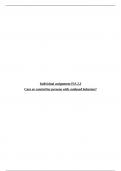Essay
Individual Assignment The Moral Compass of Contemporary Health Researchers and Professionals
- Instelling
- Maastricht University (UM)
This document contains the individual assignment for FiA 2.3 The Moral Compass of Contemporary Health Researchers and Professionals. This document is intended to use as an example of how to write this assignment. Copying = plagiarism!!! Grade = excellent
[Meer zien]




